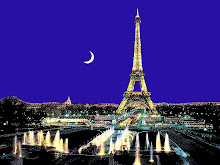Ile Saint Louis (Post # 300)
Labels :
Camille Claudel,
Ile Saint Louis,
Paris 4
Ile Saint Louis which is just east of Ile de la Cité is a combination of what previously were two smaller islands and it started to be really inhabited only in the 17th century. I have again made a comparison of what the island looked like around 1730 and today.  Actually, still today most of the buildings are from the 17th century including a beautiful baroque church. The narrow central street is full of restaurants and shops. As there is quite a lot to see and visit, I will make three different posts on this island, today rather making the tour of the exterior streets, river banks and small parks at the extreme ends.
Actually, still today most of the buildings are from the 17th century including a beautiful baroque church. The narrow central street is full of restaurants and shops. As there is quite a lot to see and visit, I will make three different posts on this island, today rather making the tour of the exterior streets, river banks and small parks at the extreme ends. 

 To give you a more clear idea of the surrounding geography I made this additional plan. Close neighbours are, in addition to Notre Dame, one of the most famous Paris restaurants (Tour d’Argent), the Arab World Institute (clearly worth a visit), la Bastille.
To give you a more clear idea of the surrounding geography I made this additional plan. Close neighbours are, in addition to Notre Dame, one of the most famous Paris restaurants (Tour d’Argent), the Arab World Institute (clearly worth a visit), la Bastille.
 Coming from Ile de la Cité and Notre Dame, you will use a pedestrian bridge, mostly occupied by some street musicians.
Coming from Ile de la Cité and Notre Dame, you will use a pedestrian bridge, mostly occupied by some street musicians.
On the island there are a lot of remarkable buildings including, on the eastern corner, the Hôtel Lambert with a lot of famous successive owners (today a Rothschild). During the 19th century it belonged to a Polish prince and was some kind of centre for Polish emigrants. Chopin was a frequent guest and most of his “polonaises” were created for the annual “grands bals” held here. The “hôtel” was designed by Louis Le Veau (or Le Vau) who during some 25 years was Louis XIV’s chief architect and contributed at Versailles, Vaux-le-Vicomte, Vincennes, Louvre, Institut de France (French Academy)… Another building designed by Le Veau is the Hôtel de Lauzun (or Lausun, front gate closed), now belonging to and restored by the City of Paris. You can here see the gate together with some others.
Another building designed by Le Veau is the Hôtel de Lauzun (or Lausun, front gate closed), now belonging to and restored by the City of Paris. You can here see the gate together with some others.  The island has had a lot of illustrious occupants, in the beginning mostly French nobility, but later also Marie Curie, Baudelaire, Daumier, Blum, Chagall, Pompidou… and still has (no names here).
The island has had a lot of illustrious occupants, in the beginning mostly French nobility, but later also Marie Curie, Baudelaire, Daumier, Blum, Chagall, Pompidou… and still has (no names here).
 One of them was Camille Claudel, who lived and worked here during 14 years after she had left Rodin and until 1913 when she was forced to leave for a mental institution where she spent her last 30 years. The gate was closed, but a nice lady let me in to take a photo also from the court yard. The apartment cannot be visited; today occupied by a well known personality (no name).
One of them was Camille Claudel, who lived and worked here during 14 years after she had left Rodin and until 1913 when she was forced to leave for a mental institution where she spent her last 30 years. The gate was closed, but a nice lady let me in to take a photo also from the court yard. The apartment cannot be visited; today occupied by a well known personality (no name).
 Actually, still today most of the buildings are from the 17th century including a beautiful baroque church. The narrow central street is full of restaurants and shops. As there is quite a lot to see and visit, I will make three different posts on this island, today rather making the tour of the exterior streets, river banks and small parks at the extreme ends.
Actually, still today most of the buildings are from the 17th century including a beautiful baroque church. The narrow central street is full of restaurants and shops. As there is quite a lot to see and visit, I will make three different posts on this island, today rather making the tour of the exterior streets, river banks and small parks at the extreme ends. 

 To give you a more clear idea of the surrounding geography I made this additional plan. Close neighbours are, in addition to Notre Dame, one of the most famous Paris restaurants (Tour d’Argent), the Arab World Institute (clearly worth a visit), la Bastille.
To give you a more clear idea of the surrounding geography I made this additional plan. Close neighbours are, in addition to Notre Dame, one of the most famous Paris restaurants (Tour d’Argent), the Arab World Institute (clearly worth a visit), la Bastille. Coming from Ile de la Cité and Notre Dame, you will use a pedestrian bridge, mostly occupied by some street musicians.
Coming from Ile de la Cité and Notre Dame, you will use a pedestrian bridge, mostly occupied by some street musicians.On the island there are a lot of remarkable buildings including, on the eastern corner, the Hôtel Lambert with a lot of famous successive owners (today a Rothschild). During the 19th century it belonged to a Polish prince and was some kind of centre for Polish emigrants. Chopin was a frequent guest and most of his “polonaises” were created for the annual “grands bals” held here. The “hôtel” was designed by Louis Le Veau (or Le Vau) who during some 25 years was Louis XIV’s chief architect and contributed at Versailles, Vaux-le-Vicomte, Vincennes, Louvre, Institut de France (French Academy)…
 Another building designed by Le Veau is the Hôtel de Lauzun (or Lausun, front gate closed), now belonging to and restored by the City of Paris. You can here see the gate together with some others.
Another building designed by Le Veau is the Hôtel de Lauzun (or Lausun, front gate closed), now belonging to and restored by the City of Paris. You can here see the gate together with some others.  The island has had a lot of illustrious occupants, in the beginning mostly French nobility, but later also Marie Curie, Baudelaire, Daumier, Blum, Chagall, Pompidou… and still has (no names here).
The island has had a lot of illustrious occupants, in the beginning mostly French nobility, but later also Marie Curie, Baudelaire, Daumier, Blum, Chagall, Pompidou… and still has (no names here). One of them was Camille Claudel, who lived and worked here during 14 years after she had left Rodin and until 1913 when she was forced to leave for a mental institution where she spent her last 30 years. The gate was closed, but a nice lady let me in to take a photo also from the court yard. The apartment cannot be visited; today occupied by a well known personality (no name).
One of them was Camille Claudel, who lived and worked here during 14 years after she had left Rodin and until 1913 when she was forced to leave for a mental institution where she spent her last 30 years. The gate was closed, but a nice lady let me in to take a photo also from the court yard. The apartment cannot be visited; today occupied by a well known personality (no name).Some of these pictures can also be found on my photo blog.
This is my 300th post (on this blog) in 315 days - my first post was made March 22nd last year.






 La Conciergie served as prison until 1914.
La Conciergie served as prison until 1914.





 First some general views of the Palais - which today is the seat of local and national courts of justice including the highest court of appeal. It covers some 200 thousand sq.m. (50 acres), has 24 km (15 miles) of corridors, 7000 doors… It houses some 4000 magistrates and civil servants, not mentioning the thousands of more or less voluntary daily visitors.
First some general views of the Palais - which today is the seat of local and national courts of justice including the highest court of appeal. It covers some 200 thousand sq.m. (50 acres), has 24 km (15 miles) of corridors, 7000 doors… It houses some 4000 magistrates and civil servants, not mentioning the thousands of more or less voluntary daily visitors. The clock you see in the top is from 1585 (it works) and it replaces what was the oldest public clock in Paris which was put there some 200 years before. You find it on the square tower called “Tour d’Horloge”, the Clock Tower, which was built as watch tower.
The clock you see in the top is from 1585 (it works) and it replaces what was the oldest public clock in Paris which was put there some 200 years before. You find it on the square tower called “Tour d’Horloge”, the Clock Tower, which was built as watch tower. Tomorrow, we will visit the fabulous Sainte Chapelle.
Tomorrow, we will visit the fabulous Sainte Chapelle.



 To continue on Boulevard des Capucines we will first cross the Place de L’Opéra with a view of
To continue on Boulevard des Capucines we will first cross the Place de L’Opéra with a view of 







 There are a number of theatres along these boulevards, most of them from the 19th century. Sarah Bernhardt played and directed as well at Théatre de la Renaissance as at Théatre de la Porte Saint Martin (the middle top photo), where also Edmond Rostand presented the Cyrano de Bergerac. At the as a historic monument classified Théatre des Variétés (the photo to the right) a number of Offenbach’s comic operas were performed for the first time.
There are a number of theatres along these boulevards, most of them from the 19th century. Sarah Bernhardt played and directed as well at Théatre de la Renaissance as at Théatre de la Porte Saint Martin (the middle top photo), where also Edmond Rostand presented the Cyrano de Bergerac. At the as a historic monument classified Théatre des Variétés (the photo to the right) a number of Offenbach’s comic operas were performed for the first time. I have already referred to the perhaps most famous Paris - and Europe’s biggest - cinema,
I have already referred to the perhaps most famous Paris - and Europe’s biggest - cinema,  Along our walk we will also see two Arches of Triumph, Saint Martin and Saint Denis, both built under the reign and to the glory of Louis XIV. They were then on the border of Paris, on the way you then entered Paris from the north via rue Saint Denis (see
Along our walk we will also see two Arches of Triumph, Saint Martin and Saint Denis, both built under the reign and to the glory of Louis XIV. They were then on the border of Paris, on the way you then entered Paris from the north via rue Saint Denis (see  There are some nice and typical Paris streets to the right and to the left of the boulevards…
There are some nice and typical Paris streets to the right and to the left of the boulevards… … and you can also find some interesting pedestrian passageways:
… and you can also find some interesting pedestrian passageways: Passage Jouffroy, neighbour to our Mme Tussauds (Musée Grévin), created in 1847, with more fashionable shops, hotels…
Passage Jouffroy, neighbour to our Mme Tussauds (Musée Grévin), created in 1847, with more fashionable shops, hotels… Passage des Panoramas, the most elegant of the three, in its present shape there since 1834 with some very old shops, restaurants…and neighbour to Théatre des Variétés, meaning that it was especially in fashion during the glorious Offenbach years (see above).
Passage des Panoramas, the most elegant of the three, in its present shape there since 1834 with some very old shops, restaurants…and neighbour to Théatre des Variétés, meaning that it was especially in fashion during the glorious Offenbach years (see above).



 The place is of course mostly known for the monument, “La République”, which was inaugurated - before it was quite ready - for the first official celebration of the 14th of July as a national holiday in 1880. A new inauguration took place when it was completed in 1883. It was created by two brothers Morice.
The place is of course mostly known for the monument, “La République”, which was inaugurated - before it was quite ready - for the first official celebration of the 14th of July as a national holiday in 1880. A new inauguration took place when it was completed in 1883. It was created by two brothers Morice. The monument is rich in decorations: You have also three sculptures representing “Liberté, égalite, fraternité”. Although “Liberty, Equality, Brotherhood (– or Death)” was an essential message already during the 1789 Revolution, it became an official motto only a few decades later. Once again these are feminine words in French and represented by women.
The monument is rich in decorations: You have also three sculptures representing “Liberté, égalite, fraternité”. Although “Liberty, Equality, Brotherhood (– or Death)” was an essential message already during the 1789 Revolution, it became an official motto only a few decades later. Once again these are feminine words in French and represented by women.














